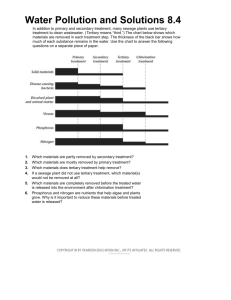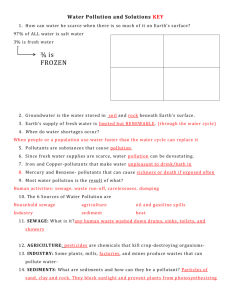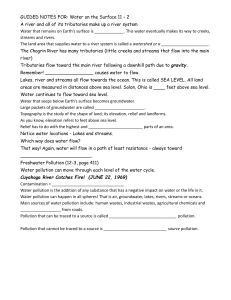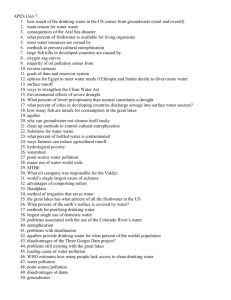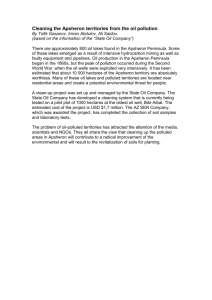Water Pollution
advertisement
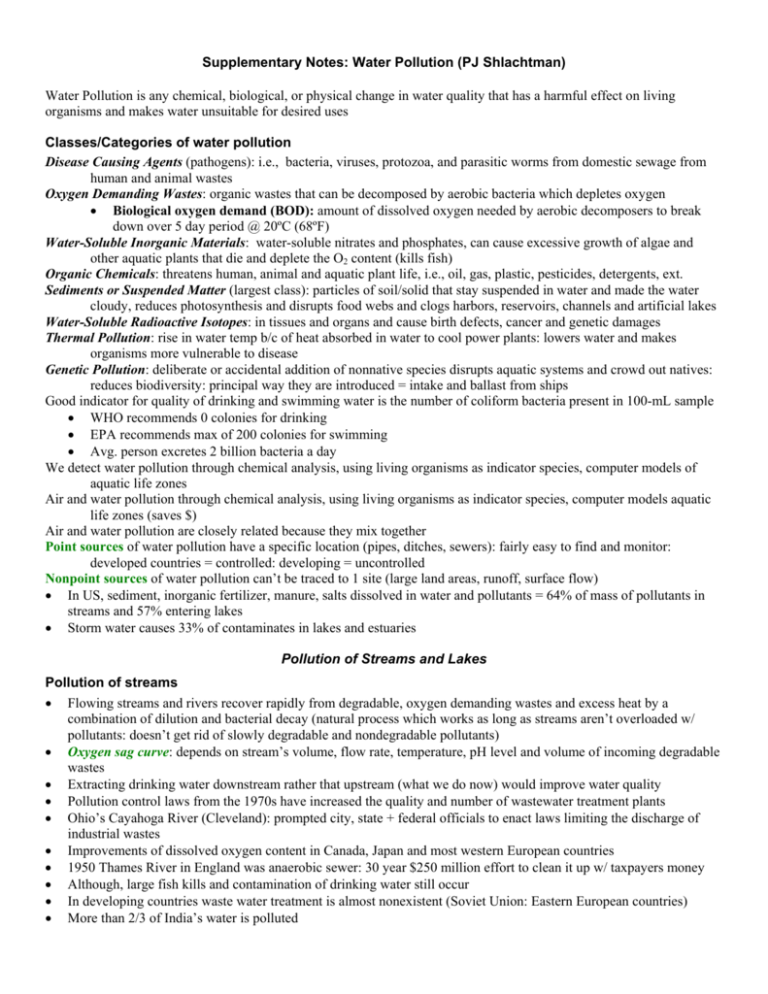
Supplementary Notes: Water Pollution (PJ Shlachtman) Water Pollution is any chemical, biological, or physical change in water quality that has a harmful effect on living organisms and makes water unsuitable for desired uses Classes/Categories of water pollution Disease Causing Agents (pathogens): i.e., bacteria, viruses, protozoa, and parasitic worms from domestic sewage from human and animal wastes Oxygen Demanding Wastes: organic wastes that can be decomposed by aerobic bacteria which depletes oxygen • Biological oxygen demand (BOD): amount of dissolved oxygen needed by aerobic decomposers to break down over 5 day period @ 20ºC (68ºF) Water-Soluble Inorganic Materials: water-soluble nitrates and phosphates, can cause excessive growth of algae and other aquatic plants that die and deplete the O2 content (kills fish) Organic Chemicals: threatens human, animal and aquatic plant life, i.e., oil, gas, plastic, pesticides, detergents, ext. Sediments or Suspended Matter (largest class): particles of soil/solid that stay suspended in water and made the water cloudy, reduces photosynthesis and disrupts food webs and clogs harbors, reservoirs, channels and artificial lakes Water-Soluble Radioactive Isotopes: in tissues and organs and cause birth defects, cancer and genetic damages Thermal Pollution: rise in water temp b/c of heat absorbed in water to cool power plants: lowers water and makes organisms more vulnerable to disease Genetic Pollution: deliberate or accidental addition of nonnative species disrupts aquatic systems and crowd out natives: reduces biodiversity: principal way they are introduced = intake and ballast from ships Good indicator for quality of drinking and swimming water is the number of coliform bacteria present in 100-mL sample • WHO recommends 0 colonies for drinking • EPA recommends max of 200 colonies for swimming • Avg. person excretes 2 billion bacteria a day We detect water pollution through chemical analysis, using living organisms as indicator species, computer models of aquatic life zones Air and water pollution through chemical analysis, using living organisms as indicator species, computer models aquatic life zones (saves $) Air and water pollution are closely related because they mix together Point sources of water pollution have a specific location (pipes, ditches, sewers): fairly easy to find and monitor: developed countries = controlled: developing = uncontrolled Nonpoint sources of water pollution can’t be traced to 1 site (large land areas, runoff, surface flow) • In US, sediment, inorganic fertilizer, manure, salts dissolved in water and pollutants = 64% of mass of pollutants in streams and 57% entering lakes • Storm water causes 33% of contaminates in lakes and estuaries Pollution of Streams and Lakes Pollution of streams • Flowing streams and rivers recover rapidly from degradable, oxygen demanding wastes and excess heat by a combination of dilution and bacterial decay (natural process which works as long as streams aren’t overloaded w/ pollutants: doesn’t get rid of slowly degradable and nondegradable pollutants) • Oxygen sag curve: depends on stream’s volume, flow rate, temperature, pH level and volume of incoming degradable wastes • Extracting drinking water downstream rather that upstream (what we do now) would improve water quality • Pollution control laws from the 1970s have increased the quality and number of wastewater treatment plants • Ohio’s Cayahoga River (Cleveland): prompted city, state + federal officials to enact laws limiting the discharge of industrial wastes • Improvements of dissolved oxygen content in Canada, Japan and most western European countries • 1950 Thames River in England was anaerobic sewer: 30 year $250 million effort to clean it up w/ taxpayers money • Although, large fish kills and contamination of drinking water still occur • In developing countries waste water treatment is almost nonexistent (Soviet Union: Eastern European countries) • More than 2/3 of India’s water is polluted • 54 out of 78 monitored streams in China are polluted and 20% of its rivers are too polluted to use for irrigation Pollution of Lakes • In lakes, reservoirs, and ponds, dilution is less effective than in streams • Stratified layers, volumes of water w/ little flow (reduces levels of dissolved oxygen) • Flushing and changing of water in lakes and large artificial reservoirs takes 1-100 years • More vulnerable to contamination by plant nutrients, oil, pesticides, and toxic substances: destroy bottom life, and fish and birds that feed on contaminated aquatic organisms • Thousands of waterfowl and fished died at the Kesterson National Wildlife Refuge in the San Joaquin Valley in CA due to selenium contaminated water flowing into the lakes • Eutrophication: natural enrichment of lakes • Cultural Eutrophication: process of human activities accelerating the input of nutrients • Animal wastes fertilizes cropland and is stored in pits and lagoons that can pollute the air • 1996: more that 40 animal waste spills killed 670,000 fish in Iowa, Minnesota and Missouri • Hot weather and droughts produces more bacteria • 1/3 of the 100,00 medium-large lakes and 85% of the large lakes near modern population centers in the US suffer from some sort of cultural eutrophication • Prevention of cultural eutrophication = advanced waste water treatment which bans/ limits the amount of phosphates in detergents, soil conservation, and land use control • Cleanup methods = dredging bottom sediments, removing excess weeds, controlling plant growth w/ herbicides and algaecides, pumping air thorough lakes and reservoirs • Prevention is more effective and usually cheaper in the long run than pollution control • Seattle’s Lake Washington = success story from eutrophication when sewage was diverted into Puget Sound Great Lakes • 5 Great Lakes contain at least 95% of fresh surface water in US and 20% of the world’s fresh surface water • Basin of the lakes is home for 30% of the Canadian population and 14% of the US population • Vulnerable to pollution from point and nonpoint sources, i.e., land runoff, acids, pesticides, other toxic chemicals • 1960s and 1970s: Lake Erie, beaches closed, lost almost all native fish: 1972 = $20 billion pollution-control program with Canada and US • DDT and PCBs flow into lakes from land runoff, streams and atmospheric deposition • Great lakes fisheries also face threats form genetic pollution • 1986 = zebra mussel (no known natural enemies) invaded the lakes and depleted the food supply for other lake species: costs $500 million per year and could reach $5 billion • 1991 = invasion of the quagga mussel Streams and Lakes polluted by heat • 2/3 of the energy in the fuel used by coal-burning and nuclear power plants is converted to heat that must be dissipated into the environment; cheapest and easiest way to withdraw the surface water to cool the plant, is to pass it through the pant and return the heated water back to the lake: ½ water withdrawn in US is for cooling electrical power plants • Thermal shock: the effect of sharp changes in water temperature (kills fish that can’t adapt) • Thermal enrichment: beneficial uses of heated water o Lengthens the commercial fishing season, reduces winter ice cover in cold areas, can extend the growing seasons, help heat nearby buildings and greenhouses • Ways to reduce/ control thermal water pollution o Use and waste less energy o Limiting the amount of heated water discharged into a body of water o Returning the heated water to a place that is away from the ecologically vulnerable shore zone o Transferring the heat from the water to the atmosphere by means of huge cooling towers o Discharging the heated water into shallow ponds or canals, and reusing it as cooling water Ocean Pollution • Oceans are the ultimate sink for waste • “Water may flow in a thousand channels, but it all returns to the sea” • Oceans can dilute, disperse, and degrade large amounts of raw sewage, sewage sludge, oil, and some types of industrial waste • It is generally safer to dump sewage sludge and most other hazardous wastes in the deep ocean because marine life is generally more resilient • Costal areas have enormous inputs of wastes • Half the world’s population lives on or within 100 kilometers (160 miles) of the coast • The most polluted seas lie off the densely populated coasts of Bangladesh, India, Pakistan, Indonesia, Malaysia, Thailand, and the Philippines: about 85% of the sewage from large cities along the Mediterranean is discharged into the sea untreated • In the US about 35% of municipal sewage ends up virtually untreated: Actors from Baywatch get paid extra to go into the Santa Monica Bay because it is so polluted • Runoff of sewage and agriculture wastes into coastal waters and acid deposition from the atmosphere introduce large quantities of nitrogen + phosphorous, which can cause explosive growth or bloom of algae or other organisms Chesapeake Bay • Chesapeake Bay is the largest estuary in the US • Between 1940 and 1995 the # of people living in the Bay area grew from 3.7 million to 15.5 and will soon reach 18 • Receives wastes from point and nonpoint sources (9 large rivers, 141 smaller streams and creeks from 6 states) • The Bay is shallow and only 1% of the waste entering it is flushed to the Atlantic • Levels of phosphates and nitrates have risen: point sources contribute 60% by weight of the phosphates and nonpoint sources contribute about 60% by weight of the nitrates • Air pollutants account for almost 35% of the nitrogen entering the estuary • In 1980s the Chesapeake Bay Program was the country’s most ambitious attempt at integrated coastal management • Results were impressive: between 1987 and 1993 phosphorus levels dropped 16%: nitrogen levels dropped 7% : the drops led to a 75% increase in the abundance of submerged vegetation between 1978 and 1993 and the bass population rebounded • In 1997 federal and state officials offered farmers in Maryland more that $250 million in subsidies to leave potential cropland near the bay unplanted (Back to the oceans) • Dumping of industrial waste off US coasts has stopped but still occurs in other developed and developing countries • Barges and ships still legally dump large quantities of dredge spoils (materials laden w/ toxic metals scraped from the bottoms of harbors and rivers to maintain shipping channels) at 100 sire off the Atlantic, Pacific and Gulf coasts • Sewage Sludge: a gooey, mudlike mixture of toxic chemicals, infectious agents, and settled solids removed from wastewater at treatment plants • Since 1992 this process has been banned • 50 countries with at least 80% of the world’s merchant fleet have agreed not to dump sewage and garbage at sea, but it is difficult to enforce and is often violated • London Dumping Company of 1972 • 1994: became a permanent ban (see page 546) Oil • Crude petroleum + refined petroleum + other processed petroleum products are accidentally or deliberately released into the environment from a # of sources • Tanker spills and blowouts, offshore drilling rig accidents, • Almost ½ of the oil reaching the oceans is waste oil dumped, spilled, or leaked onto the land or into sewers by cities, individuals and industries • The effects of oil on ocean depend on o The type of oil (crude or refined), o amount released, • • • • • • • • • • • • • • • • • • o distance of release from shore, o time of year, o weather conditions, o average water temperature o ocean currents Research shows that most (but not all) forms of marine life recover from exposure to large amounts of crude oil within 3 years: Recovery from exposure to refined oil take >10 yrs Moderate oil spills can be cleaned up by mechanical, chemical, fire, and natural methods Mechanical methods include: o Floating booms to contain the oil spill or keep it from reaching sensitive areas o Skimmer boats to vacuum up some of the oil into collection barges o Absorbent pads or large feathered filled pillows to soak up oil on beaches or in waters to shallow for skimmer boats Chemical methods include: o Coagulating agents to cause floating oil to clump together for easier pick up or sink to the bottom where is usually does less harm o Dispersing agents to break up oil slicks Methods remove only part of the oil and none work well on a large spill: preventing it is cheaper Oil is responsible for most of the world’s air pollution o Exxon Valdez: March 24, 1989 = worst oil spill even in US waters: coated more than 1,600 kilometers (1,000 miles) (see page 547+548) Key to protecting the oceans is to reduce the flow of pollution from the land and from streams emptying into the ocean (see page 549 for a list of prevention methods and cleanup methods) Solutions: Preventing and Reducing Surface-Water Pollution The leading nonpoint source of water pollution is agriculture o Farmers can sharply reduce fertilizer runoff into surface waters and leaching into aquifers by using moderate amounts of fertilizer and by using none at all on steeply sloped land and planting buffer zones between rows of crops and applying pesticides only when needed o Livestock growers can control runoff and infiltration of manure from feedlots and barnyards by managing animal destiny, planting buffers and not locating feedlots on land near surface water when land slopes towards the water The Federal Water Pollution Control Act of 1972 (renamed the Clean Water Act in 1977) and the 1987 Water Quality Act form the basis of the US efforts to control pollution of the country’s surface waters EPA developed a discharge trading policy in 1995 to use market forces to reduce water pollution (see page 550 to learn more about the Acts) Septic Tank: in rural and suburban areas with suitable soils. Sewage from each house is usually discharged into these o About 25% of all homes in the US are served by septic tanks which need to be cleaned out every 3-5 years) Primary Sewage Treatment: a mechanical process that uses screens to filter out debris such as sticks, stones, and rags; suspended solids settle out as sludge in a settling tank Secondary Sewage Treatment: a biological process in which aerobic bacteria are used to remove up to 90% of biodegradable, oxygen demanding organic wastes o Trickling filters, activated sludge process Advanced Sewage Treatment: a series of specialized chemical and physical processes that remove specific pollutants left in the water after primary and secondary treatment: types of advanced treatment vary according to the specific contaminants being removed Before water is discharged after primary, secondary, or advanced treatment, it is bleached and disinfected (usually by chlorination) Some communities and individuals are seeking better ways to purify contaminated water by working with nature Scientists at Living Technologies are also developed neighborhood –level sewage walls that would run along the length of a residential block In developing countries, a promising new technology for processing domestic waste is the SIRDO system (double vault) • • • • • • • • • • • • • • • • • • Groundwater Pollution and its Prevention Pollutants in drinking water is a high-risk health problem When is becomes contaminated, it cannot cleanse itself of degradable wastes, as surface water can if it is not overloaded Crude estimates indicate that up to 25% of usable groundwater in the US is contaminated Groundwater can be contaminated from a number of sources: o Underground storage tanks o Landfills o Abandoned hazardous waste dumps o Deep wells used to dispose of liquid hazardous wastes o Industrial waste o Livestock waste storage lagoons EPA estimates at least 1 million underground tanks of gas, diesel fuel and toxic solvents are leaking into groundwater Determining the extent of a leak costs between $25,000-250,000 and cleanup costs are from $10,000-250,000 depending on the size and a complete cleanup is rarely possible: replacing a leaking tank adds an additional $10,00060,000 Pumping polluted groundwater to the surface and cleaning it up is too expensive and it would take between 50-1,000 years to clean it all up (for more prevention and cleanup methods see page 556) Drinking Water Quality Many rivers in eastern Europe, Latin America, and Asia are used as sources of drinking water but are contaminated with pesticides, fertilizers and hazardous organic chemicals In China 41 large cities get their water from polluted groundwater In Russia ½ of all tap water is unfit to drink and 1/3 of the aquifers are too contaminated for drinking purposes Treatment of water for drinking by city dwellers is like wastewater treatment About 54 countries (most in N. America and Europe) have safe drinking water 64 contaminates are currently tested for in drinking water Privately-owned wells don’t have to meet federal drinking water standards In Milwaukee, Wisconsin and Las Vegas, Nevada there was an outbreak of Cryptosporidium in 1993 + 1994 Congress is trying to weaken the Safe Drinking water Act and Environmentalists are trying to get it strengthened (see page 557) The US has one of the world’s best drinking water supply systems We need to shift our emphasis from pollution cleanup to pollution prevention: o Source reduction o Reuse of wastewater o Recycling pollutants o We need to accept that the environment (air, water, soil, life) is an interconnected whole


